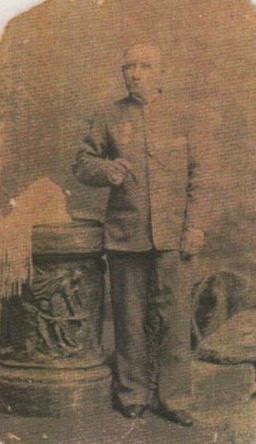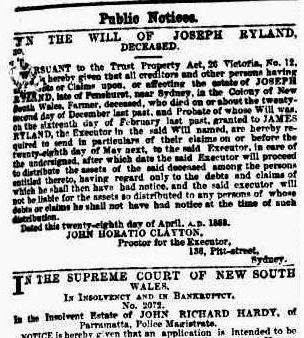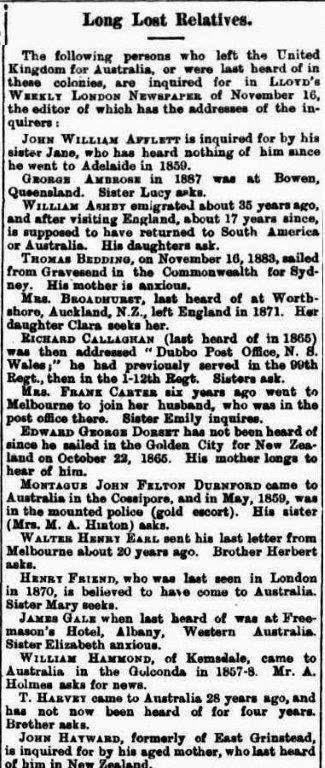 The family were in Musswelbrook in 1872, as the previous stories confirmed.
The family were in Musswelbrook in 1872, as the previous stories confirmed.Then he appears to be back working on coaches in 1873.
Then in 1874 everyone is missing.
Nothing is heard from them until Montagu decides to remarry.
1875 he is 44 and he marries 18 year old Agnes Matilda Ryland.
Agnes Matilda Ryland
She was the daughter of Joseph Reyland and his wife Ann Corbett.
From other researchers mention is made of Joseph being born in Liverpool, but there are so many Josephs. However he had to get to Australia in some way or other, and the best match would seem to be John Reyland.
He was charged and tried at the December Lancaster Assizes and sent to Australia arriving 1837, for the usual 7 years. He arrived on the ship Lloyds on 25th March 1837, and was granted his ticket of leave January 1844.
 |
| Dublin memorial |
As part of our trip to the UK one aspect which was quite sad was the Workhouses. Every person who arrived in Australia was initially processed in the workhouse. The Australian government had a programme in place with Ireland to sponsor the immigration of young unmarried women, who would provide the male residents with a choice of "Wife".
These numbers increased dramatically in the 1840s when the potato crops in Ireland were destroyed by disease resulting in famine for the people. Ireland's population of 8 million was halved. Two million people died and two million emigrated including 23 000 to Australia. Between 1848 and 1850, over 4000 young women orphaned by the famine were sent to Australia to work mainly as domestics for established families. Most married soon after, raising families of their own.
Each county was divided into what they called a Union, and outside each major town of the Union a workhouse was built. In the one we visited the stories of the numbers who died were staggering. Sometimes they just piled up bodies in the front grounds, to await the burial cart.
In another town there are thousands buried in one mass grave.
Conditions in the workhouses were as the following information states:
The Workhouse and Its Staff
All Workhouses were built to the same standard specification and were built to comprise either 400 or 800 inmates. They were always situated outside a Main Union Town, and the Workhouse and its grounds were surrounded by high Stone Walls on all sides, with Iron Gates at the entrance, separating the Workhouse and its inmates from the rest of Society.Workhouse staff consisted of the Master, responsible for the general running of the Workhouse, dealing with admittances, discharges, boarding outs, and general domestic affairs of the Workhouse. The Matron was responsible for the Women Inmates in the Workhouse. Other staff included Workhouse Chaplains (of all denominations), One Teacher, a Laundry Maid, Cook, and One Medical Officer.
Life in the Workhouse, 1839-45
Admission to the local Workhouse was based on very strict criteria. Priority went to the old and/or infirm, and destitute children who were unable to support themselves. The Guardians were also given discretion to admit the destitute poor.People entered the Workhouse for a variety of reasons - unemployment and the famine were the main reasons for admittance in the 19th Century, however the Workhouse also provided a safe-haven for unmarried pregnant girls, married women whose husbands had deserted them, and Orphaned Children whose relatives were too old or too poor to care for them.
The Workhouse was a last resort for most people, who would take on any work, rather than face the gruelling Workhouse regime. The Guardians also applied the strictest of Work regimes to ensure that only the desperately poor would seek admission.
Upon Admission what few personal effects and clothing the inmates came in with, were washed and put into storage, and Inmates were given a Standard Issue Workhouse Uniform to wear.
Inmates were then categorized into male/female, able-bodied, old/infirm, infants/children. All Classes of Inmates were separated from each other, and communication between Classes was strictly forbidden. In the case of Families having been admitted, this meant that husbands and wives were banned from seeing each other, and mothers were banned from seeing their children (although this latter prohibition was later relaxed so that mothers were able to book appointments to see their children on a weekly basis).
 |
| County Clare |
Living Accomodation
Workhouse Living Accomodation was cold, damp and cramped – Sleeping Dormitories were situated in the attics, and consisted of Male and Female Dormitories, and Children's Dormitories. The Inmates were generally kept apart both day and night, with separate yards and duties. Beds consisted of straw mattresses placed on the floor, with old rags for sheeting. Beds were no more than 2 feet apart Disease was commonplace as no proper toilet facilities were in place. Baths were meant to be taken once a week, and Bathing Registers were kept for this purpose - the reality was often very different.Inmates' Duties
Once admitted, Inmates were required to work a minimum 11 hour day. Inmates were put to work on a variety of jobs. Some Workhouses established Local Trade Workshops for eg. Weaving/Sewing/Knitting/Cobbling/Tailoring/Carpentry etc. Able-bodied Female Inmates would either be given Sewing Duties or Kitchen Duties (preparing and cooking Workhouse Meals, and Washing Up) Cleaning of the Workhouse, Nursery duties, or Laundry Duties.Able-bodied Male Inmates worked much harder, quarrying and smashing stones, building workhouse boundary walls, chopping wood, and grinding corn, tending the Workhouse Vegetable Gardens/Farms, digging cess pools, burying the dead, stoking the Workhouse fires, etc.
The Daily Routine for Adult Inmates was as follows:
Workhouse Punishments
Punishments for any breach of Workhouse Rules were very harsh. An inmate who refused to carry out their Work Duties would be given 24 lashes plus no Dinner for one week. An inmate who used abusive language would be put into solitary confinement plus no Dinner for One Week, or more. Female Inmates who breached rules could often be forced to break stones for One Week, and so forth. After all, Workhouse Life was not meant to be pleasant.
Spare a thought for all our Irish ancestors! There were 33 other ladies like Ann on the manifest page. The Donaghmore Workhouse is now a museum.
Joseph and Ann marry in 1843 in Cook's River Petersham New South Wales.
They have four children
Charles 1846 - 1877
Mary Martha Reyland 1850 - 1933
James Joseph Reyland 1853 - 1895
Agnes Matilda Reyland 1857 - 1888
In 1859, during a storm, poor Ann and her son Charles were struck by lightning. Ann unfortunately died, and Charles was lucky to survive. Her death from the coroner indicated a Visitation of Providence.
Joseph then was left with rearing the 4 children. He may have run a business of some sort. He died in 1887 and left an estate of over one thousand pounds.
Charles married Susanna MArgaret Parks and unfortunately he died in 1877, aged 31, from injuries.
Mary Martha married Joseph Parkes and she died in 1933.
Joseph James married Sarah Cracknell and he died in 1895
Agnes Matilda married Montagu Durnford 1875 and she died in 1888.
*********************************************************************************
In 1876 Agnes has a child Frederick Andrew Harvey Durnford

Then in 1878 she is admitted to the Sydney Benevolent Asylum where she Joseph Durnford was born, 27th January 1878
She was admitted as Agnes Darnsford and discharged as Agnes Dunsford.
With the influx of free immigrants after 1840, demands on the society increased. In 1852, the society was granted the use of Liverpool Hospital for its male inmates. Ormond House at Paddington was donated for temporary use and in 1859 50 children were transferred to the Asylum for the Relief of Destitute Children at Randwick. Overcrowding threatened the health of the inmates, and in March 1862 the government resumed the Liverpool Asylum and transferred the aged and infirm women to the Hyde Park Barracks.
Under Dr Arthur Renwick, who served from 1862 to 1908, and Matron Elizabeth Elric (née Blundell, one of Florence Nightingale's trainees), the Benevolent Asylum operated as a lying-in hospital, foundling institute and a refuge for deserted mothers and destitute children. This continued the work begun by the first Ladies' Committee, formed in 1820, which assisted poor married women during childbirth. Applications for admissions and relief were reviewed by a reconstituted committee, who remodelled the building. In 1878, the committee was replaced by a Board of Directors which, controversially, specifically excluded members of the clergy. The non-denominational society campaigned for social reform to assist deserted mothers, children and the aged.
In 1881 some of those belongings were recovered, and a Mary Ann Powe arrested.

11th November 1887, Agnes' brother, James puts an advertisement in the newspaper asking her to contact him at Cook's River.
Her brother was trying to contact her regarding their father's will in 1888
In 1888 Agnes dies she was living in Harwood Lane Prymont
.
It is assumed that the children are taken in by her brother James and his wife.
In 1891 Joseph Durnford dies. He had been living with his uncle at Tempe, Cooks River.
James was buried at St Peters Church in Cooks River
James was buried at St Peters Church in Cooks River
Perhaps Frederick was also with his uncle James and his wife.
James Joseph and his wife Sarah were living in Cooks River Road, St Peters, and in 1890 indicated he was a storekeeper.
Or he may have also left at some point after the death of his uncle in 1895, as by 1901 he is in Western Australia.
There is a record in 1895 in West Australia for a mining license for F.W. Dunsford.
In 1901 he marries Ivy Williamson, in Clermont in West Australia.
There is a record in 1895 in West Australia for a mining license for F.W. Dunsford.
From 1903 until his death in 1925, he was involved in a lot of mining, from Coolgardie, Dampier, Wyndham, Kalgoolie and he died in Northam.
Black Range Districk Gold Mining Lease 382B Bull Oak - Frederick Durnford 1917
*********************************************************************************
So to recap againBy 1875 he has remarried
The ages of his children then:
Edward probably around 15
Montagu probably around 13
Francella would be 11
Charlotte would be 8
In 1882 Francella marries in Sydney Did he have the girls with him and then married Agnes.
In 1883 Charlotte marries but she is living in Newcastle. Perhaps with her uncle .
 There is an entry in 1884 in the Sands Directory of Montagu Durnford living at Mansfield Street Balmain as a contractor.
There is an entry in 1884 in the Sands Directory of Montagu Durnford living at Mansfield Street Balmain as a contractor.In 1889 in Brisbane he is at a hearing which favoured the defendent
In 1891 he receives more mail from his sister, and this time he responds, living at Flinder's River.
.


Was he back following the Gold and Coach trails?
Cobb & Co Coach
The discovery of gold at the Woolgar fields 113 km north of the town resulted in a rush to the area and Richmond became an important point for the Cobb & Co coaches which moved miners through the area. This historic link is recalled in Goldring Street, adjacent the mill, with a superbly preserved Cobb & Co coach which once conveyed people along a route which followed the Flinders River.
An image of a Cobb & Co. coach, fully laden with passengers crossing the Flinders River at Gillespie Crossing (at the eastern end of Brodie Street, Hughenden), ca.1890.
Then there is nothing more heard of him between 1891 and 1899 when he leaves to return to England.
He arrives February 1900 and goes to live at Compton Bishop in Somerset England with his sister
Amelia and her daughter.
He dies 7th August 1901 in Somerset. St Andrew's Church is the Anglican church.
*********************************************************************************













No comments:
Post a Comment